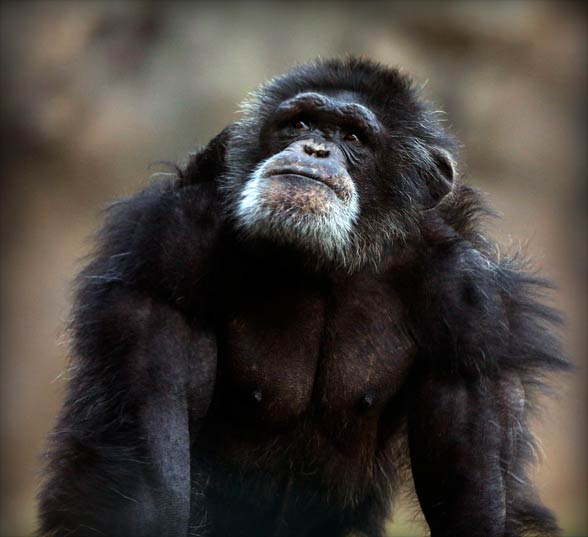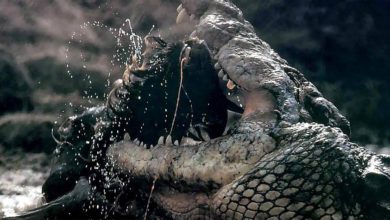Chimpanzees from Bili Forest
For about 100 years, people have been talking about giant chimpanzees from northern Congo, which are able to kill a leopard or even a lion. In 1996, the legendary cryptid turned out to be a true animal, which has features of both the chimpanzee and the gorilla. Let us get to know the huge monkeys, which despite their size and strength, approach the man with great curiosity and gentleness.
Classification
- Class: Mammalia
- Order: Primates
- Family: Hominidae
- Genus: Chimpanzee
According to the preliminary genetic studies, the Bili apes are closely related to the eastern subspecies of the chimpanzee – Pan troglodytes schweinfurthii.

Occurrence and habitat
As the name suggests, these chimpanzees live in the Bili Forest, located in the north of the Democratic Republic of Congo, about 200 km (124 mi) on the east of the Ebola River. This place is famous for its vast rainforests separated by savannah. It is a virtually secluded country because dense jungles and civil wars make it impossible to intervene in civilization. Nevertheless, it suffers the most from poaching and gold mining, which has a destructive impact on its megafauna, including the chimpanzee populations from the Bili Forest.
Characteristic
Appearance
The observed individuals are able to walk upright and with their body structure, they resemble huge chimpanzees. However, similarly to their smaller relatives, they can move on four limbs.
According to the researchers, these chimpanzees have a very flattened face, wide muzzle, and their fold of the eyebrows is straight and strongly protruding; in some individuals, it resembles the gorillas’, in others, the chimpanzees’. From the early years, they have a gray coat, regardless of gender. This feature distinguishes them from gorillas, where graying occurs only in the oldest males and only covers the loins and buttocks. They are similar in size to an adult man.

Behavior
In terms of habitat, the Bili apes behave more like gorillas, because they build their nests on the ground (yet they choose trees for their homes) – about one-fifth of all nests are located on the ground. However, the diet they have is more similar to this of chimpanzees, because it consists mainly of fruit (figs).
Although they do not display aggression towards people, they are not afraid of them. When a Bili ape encounters a man, it faces him in order to identify him and then quietly walks away. Cleve Hicks, an American primatologist’s group, has talked about the incident when in the middle of the jungle, away from human headquarters, it met a group of Bili apes. Not only did they approach people, but they surrounded them in order to “see” them.
Hicks explained that if they had noticed a group of people from a distance, they would have escaped. The smaller distance makes them more curious, although the adult monkeys show a greater degree of deliberation and fear.

Lions’ killers?
From the species’ discovery, and even earlier, in the eyes of the natives, it is considered to be aggressive and ruthless when confronted with the greatest predators in Africa – lions and leopards. It was suggested that these apes could hunt and kill those big cats. The opinion has also been proven on the basis of a dead leopard, eaten by a group of chimpanzees. Although scientists are not sure whether it was killed by the primates, the myth about the lion killers (“lion killers”) was upheld.
To this day, however, it has not been possible to explain how chimpanzees can sleep in ground nests when there are plenty of leopards, lions, golden cats, elephants or buffaloes near them.

Two groups of Bili apes?
According to the locals, Bili apes are divided into two groups:
- Arboreal -the monkeys from this group climb high in the crowns of trees to avoid ground predators, but are susceptible to the attacks of local hunters shooting them with poisoned arrows. They are not the ones referred to as “lion killers”.
- Terrestrial – they rarely climb trees, are larger and darker than the arboreal group, are not being shot with poisoned arrows. This group is referred to as “lion killers”.
Discovery
In 1996, a Swiss photographer, Karl Amman, visited the North Congo region in search of a gorilla. Instead, he found a chimpanzee-like skull, but with a shape (the fold of the eyebrow) closely resembling one of the gorillas. This fascinated seeker set cameras and video cameras there so that he would soon see monkeys resembling huge chimpanzees. Their feces were three times as large as those of chimpanzees, and footprints were much larger than those of gorillas.
In 2000, Amman returned to the same place in the company of the scientists who were examining primates. Although a living chimpanzee from the Bili Forest was not found, several abandoned ground nests characteristic of gorillas were discovered in the marshy river basins.
Early discoveries
The story of this extraordinary primate is a bit longer, as it begins in 1908 when a Belgian officer returned to his country with a few gorilla skulls he found near Bili, by the river Uele. He handed the skulls to the Royal Museum of Belgium. In 1927, the curator of the museum classified the findings as new subspecies of the Gorilla gorilla uellensis. Intrigued by the discovery of Colin Groves (an anthropologist) in 1970, examined skulls again and found that they were indistinguishable from the western gorillas’ skulls. Since then, the search for unusual gorillas has been held until 1996.

Detailed data / dimensions
Bili apes
- Height: above 152 cm (above 5ft)
- Length of the skull:
- about 22 cm (8.7 in) (4 out of 5 found skulls are longer than chimpanzee’s skull, measuring 220 mm, while chimpanzee’s skull may reach 190 – 210 mm (7.5 – 8.3 in)
- Length of feet: 28 – 34 cm (11 – 13.4 in) – larger than the largest chimpanzees and gorillas
Bili apes – curiosities
- Many scientists believe that chimpanzees from the Bili Forest are a kind of lost evolution link between humans and chimpanzees.
- Adult males are more afraid of humans than females.




















Apes and monkeys are two vastly different species. You article is both erroneous and confusing. You start off describes Bill Apes correctly as apes, the you show your own ignorance by calling them monkeys. Please, take some time to educate yoyrself, then correct this article.
You are wrong – we recommend looking into the taxonomy. Apes and monkeys are not two different species, as you wrote. Apes (Hominoidea) are a branch of Old World monkeys.
Apes emerged within “monkeys” as sister of the Cercopithecidae in the Catarrhini, so cladistically they are monkeys as well. There has been resistance to directly designate apes (and thus humans) as monkeys, so “Old World monkey” may be taken to mean the Cercopithecoidea or the Catarrhini. That apes are monkeys was already realized by Georges-Louis Leclerc, Comte de Buffon in the 18th century.
Simplified; monkeys have tails and apes do not! Gorillas, chimpanzees, orangutans and bili chimpanzees are apes and tailless. Referring to them as ‘monkeys’ is incorrect.